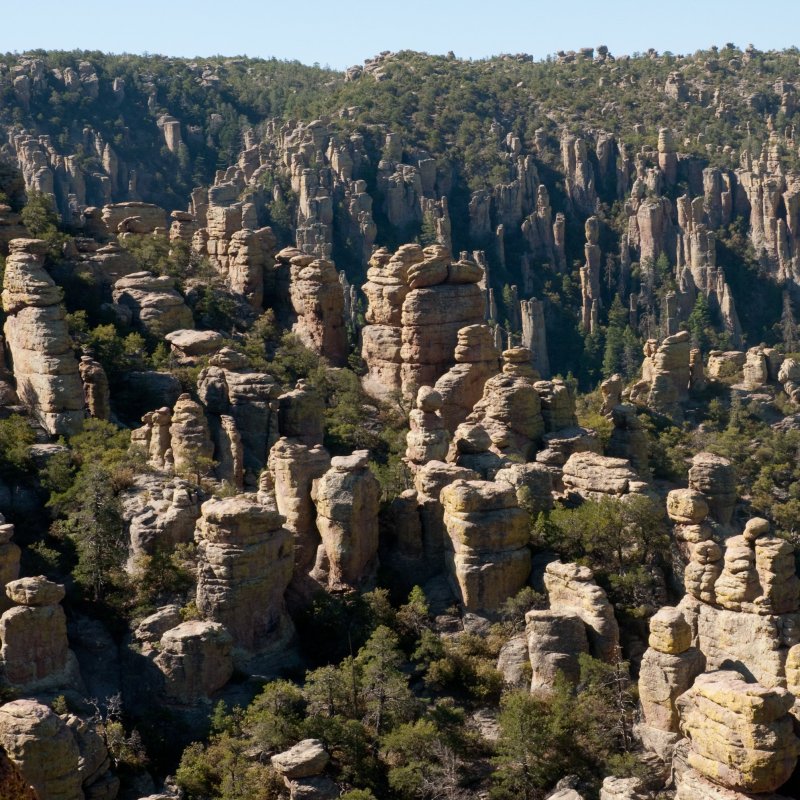
In a land of amazing rock formations, Chiricahua National Monument stands out.
Videos by TravelAwaits
After all, it’s Arizona’s top spot to see hoodoos, the thin spires of rock that seem to dance above the dry earth. And at Chiricahua, a series of rugged trails will get you right into the Heart of Rocks, where rhyolite pinnacles rise all around.
At first sight, Chiricahua National Monument in southeastern Arizona is all jagged cliffs, gnarly trees, and dusty bluffs.
But venture in deeper, and you’ll soon be surrounded by rocks, hundreds of them — balancing, standing, and spread about like hailstones.
It is the abundance of unusual rock formations that gives the national monument its nickname, Wonderland of Rocks. And it’s the rocks that make Chiricahua National Monument worthy of the long trip to get there.
Still, there is plenty more to this Arizona treasure to keep you interested once you’re there.
Here are nine things to know before you go.

1. It’s A Year-Round Destination
At just over a mile high in elevation, Chiricahua National Monument enjoys fairly mild weather year round. Spring is the optimal time to visit, with high temperatures ranging from the mid-60s in March to the low-80s in May. Autumn is also mild, with highs reaching the mid-80s in September and the mid-70s in October.
As with many Arizona locations, the summers are hot, but the average highs are considerably cooler than those in the desert cities of Tucson and Phoenix. June tends to be the hottest, with average highs in the low 90s, and July and August average in the high 80s.
Expect fairly heavy monsoon rains in July, August, and September. “Nearly every afternoon from July into September, thunderstorms occur in the area,” says the monument’s website.
Winters are cool but usually comfortable, with average highs in the 50s and 60s throughout December, January, and February. Snowstorms can occur from late fall through early spring, but snow accumulations tend to melt rapidly.

2. It’s Remote
At about 2 hours southeast of Tucson and 4 hours northwest of El Paso, Texas, Chiricahua National Monument can feel like it’s in the middle of nowhere.
That is compounded by the somewhat lonely drive southeast after leaving Interstate 10. Although the drive from the Interstate 10 town of Willcox takes only about 40 minutes, the desolate ranchland stretching on both sides of the two-lane Highway 186 makes the drive seem solitary.
It’s beautiful in its own panoramic way, though — especially in the spring, when the desert floor is carpeted in green, and the tips of spiny ocotillo cacti are aflame with red flowers.

3. There’s History Along The Way
In tune with the views that could be straight out of a Western movie is the region’s turbulent 19th-century history. About 20 miles southeast of Willcox is a turnoff for the Fort Bowie National Historic Site.
The fort site is tranquil these days, but 25 years of conflict played out between the United States Army and the Chiricahua Apache tribe throughout the late 1800s. “Today, this peaceful landscape stands in stark contrast to the violence that once gripped this land,” says the historic site’s website.
The remains of the 1860s fort and cemetery are preserved at the historic site, and a 1.5-mile moderate hike (3 miles round trip) takes visitors to the visitor center and old fort ruins.
Note that reaching the fort from the Chiricahua National Monument requires an 8-mile drive over a dusty dirt road. An alternative route is available from Interstate 10 about 23 miles east of Willcox.

4. Ranching Is At The Heart Of It
The first thing you will see upon entering Chiricahua National Monument is a small wrought-iron fenced graveyard, where a sign tells the story of the Erickson family, the pioneer settlers of the land. According to the sign, Swedish immigrants Neil and Emma Erickson established the first homestead at the site soon after marrying in 1887.
In the shade along the nearby Bonita Creek, the intrepid settlers founded Faraway Ranch, the remains of which are preserved not far from the monument entrance. Several ranch houses have been preserved, including the Stafford Cabin, a log structure that sits at the base of the mountain, and the guest house that Neil and Emma’s daughter Lillian built, along with her husband Ed Riggs, in 1923.
“Together they operated a guest ranch where visitors could enjoy the beauty of this ‘wonderland of rocks,’” says the sign. The interest they generated in the area led to the formation of the national monument in 1924.

5. Wildlife Is All Around
Don’t be surprised if you find yourself sharing the trails with a range of wild animals. When I visited in late April, I watched a herd of a half dozen or more deer graze near the banks of Bonita Creek.
Later, as I walked the creek trail between the visitor center and Faraway Ranch, I was startled when a raccoon-like animal that I later identified as a white-nosed coati (native to the area) sprang up alongside the trail, staring at me with its dark-rimmed eyes, its thick brown tail sticking straight up.
Black bears are also said to roam the Chiricahua Mountains, along with rattlesnakes and a range of migrating birds.

6. Depression-Era Workers Left A Legacy
More than 80 years ago, a small army of young men from Arizona and Texas converged on the rugged land to construct the buildings, trails, and roads of the national monument. They were part of the Civilian Conservation Corps (CCC), a work effort that President Franklin Roosevelt created to help solve the economic woes of the Great Depression.
Today, many of the CCC features remain, including the network of trails through the rocks. A sign along the creek trail says that 180 CCC enrollees arrived in June 1934 to develop the park, and they certainly left their mark.
“The picturesque canyons, spires, and balanced rocks of Chiricahua National Monument are the products of nature, but the roads and trails that lead to them are primarily the work of the Civilian Conservation Corps, or CCC,” says the sign.

7. Hiking Opportunities Abound
Ed Riggs, who served as a CCC foreman, is said to have designed the Chiricahua National Monument trail system to give the best possible views of the park features. Many of those trails endure today in the 17-mile system that takes hikers up and down canyons, along ridgelines, and past gravity-defying rock spires.
Hikes range from flat creekside walks to rugged routes with numerous rock steps. Here are a few of the best.
Easy Hikes
Following the banks of pretty Bonita Creek, the 1.2-mile Silver Spur Meadow Trail takes walkers from the Faraway Ranch, past the Stafford Cabin, and to the monument visitor center. The creek is intermittent and is often dry, but the trees along the route offer cool shade on a warm day. The walk takes less than an hour.
Moderate Hikes
The 3.3-mile Echo Canyon Loop winds through spectacular rock formations, including the Grottoes and Wallstreet, along the Hailstone Trail, and through the densely wooded Echo Park. Expect to spend about 2 hours on the loop.
Strenuous Hikes
The iconic Heart of Rocks hike consists of a round trip of 7.3 miles and more than 1,500 feet in elevation gain. For fit and adventurous hikers, it’s a must-do at Chiricahua National Monument. The hike starts at the visitor center and follows the scenic Rhyolite Canyon, the Sarah Deming Trail, and the Heart of Rocks Loop. It takes in amazing rock formations such as Big Balanced Rock, Totem Pole, and Punch and Judy. The rigorous hike can take up to 5 hours to complete.
For those who want to do everything, there’s the Big Loop, a demanding 9.5-mile route that takes in the Echo Canyon, Upper Rhyolite, Sarah Deming, Heart of Rocks, Big Balanced Rock, Inspiration Point, Mushroom Rock, and Ed Riggs Trails. It’s an all-day adventure, and the monument website suggests taking along extra food and water.

8. The Scenic Drive Offers Sweeping Views
A narrow 8-mile scenic road winds through the park, offering glimpses of many of the monument’s rock formations. From the entrance, the route climbs steadily, past the visitor center, the campground, and several roadside viewpoints. It ends at Massai Point, where several trails branch off into ravines and rock formations.
Massai Point, at an elevation of 6,870 feet, offers sweeping views of the surrounding rocks. Early National Park Service officials reportedly saw it as a major landscape viewing opportunity and built a road, as well as trails, to the high plateau.
9. Accommodations And Dining Options Are Limited
With a population of less than 4,000, Willcox, the closest town to the national monument, has a fairly limited number of hotels, but it does have a number of chain choices, including a Holiday Inn Express & Suites and a SureStay Plus by Best Western. More accommodation options are available in Benson, just over an hour away, and Tucson, about 2 hours away.
For RVers and tent campers, the monument offers the scenic Bonita Canyon Campground. Reservations can be made through Recreation.gov.
When it comes to dining, Mexican fare is your best bet. Willcox has several Mexican restaurants, including Isabel’s South of the Border and Tortilleria Taqueria La Unica.
Or, before heading out on a long day of hiking at Chiricahua National Monument, plan to stock up on snacks and picnic fixings at Willcox’s Safeway.
